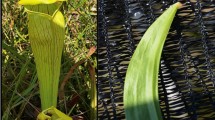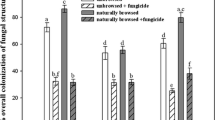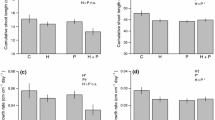Abstract
Herbivory by the specialist herbivore Exyra semicrocea on the carnivorous plant Sarracenia alata results in loss of nutrients and photosynthetic tissue (direct losses) and diminished prey capture (indirect losses). Using a combination of field surveys in a bog in Leon County, TX USA, and laboratory assays, we examined the losses of tissue and nutrients to herbivory in a population of S. alata. In a field experiment in the same bog, we manipulated herbivore access, prey capture, and supplemental (compensatory) prey to examine the relative effects of direct losses, indirect losses, and their combination on plant growth. We hypothesized that the combined effect of direct and indirect losses would be greater than the effects of either direct or indirect losses alone. Approximately 86% of pitchers in the study population had evidence of herbivory by E. semicrocea. On average, 15% of each damaged pitcher was consumed. In the field manipulation experiment, both direct and indirect losses significantly reduced growth in S. alata, but there was no significant interaction effect. As predicted, pitcher production was lowest in plants experiencing both direct and indirect losses. These results demonstrate that herbivory by E. semicrocea can be widespread and have a significant negative effect on growth of S. alata. Future studies should examine the effects of herbivory on nutrient limitation, storage in rhizomes, and sexual reproduction.



Similar content being viewed by others
References
Adamec L (1997) Mineral nutrition of carnivorous plants: a review. Bot Rev 63:273–299
Aerts R, Chapin FS (2000) The mineral nutrition of wild plants revisited: a re-evaluation of processes and patterns. In: Fitter AH, Raffaelli DG (eds), Advances in ecological research, pp 1–67
Agrawal AA (1999) Induced responses to herbivory in wild radish: effects on several herbivores and plant fitness. Ecology 80:1713–1723
Agrawal AA, Karban R (1999) Why induced defenses may be favored over constitutive strategies in plants. In: Tollrian R, Harvell CD (eds), The ecology and evolution of inducible defenses. Princeton University Press, Princeton, pp 45–61
Atwater DZ, Butler JL, Ellison AM (2006) Spatial distribution and impacts of moth herbivory on northern pitcher plants. Northeast Nat 13:43–56
Bhattarai GP, Horner JD (2009) The importance of pitcher size in prey capture in the carnivorous plant, Sarracenia alata Wood (Sarraceniaceae). Am Midl Nat 161:264–272
Bloom AJ, Chapin FS, Mooney HA (1985) Resource limitation in plants—an economic analogy. Annu Rev Ecol Syst 16:363–392
Butler JL, Ellison AM (2007) Nitrogen cycling dynamics in the carnivorous northern pitcher plant, Sarracenia purpurea. Funct Ecol 21:835–843
Coley PD, Bryant JP, Chapin FS (1985) Resource availability and plant antiherbivore defense. Science 230:895–899
Crawley MJ (1989) Insect herbivores and plant population dynamics. Annu Rev Entomol 34:531–562
Cyr H, Pace ML (1993) Magnitude and patterns of herbivory in aquatic and terrestrial ecosystems. Nature 361:148–150
Ellison AM (2006) Nutrient limitation and stoichiometry of carnivorous plants. Plant Biol 8:740–747
Ellison AM, Adamec L (2011) Ecophysiological traits of terrestrial and aquatic carnivorous plants: are the costs and benefits the same? Oikos 120:1721–1731
Ellison AM, Gotelli NJ (2009) Energetics and the evolution of carnivorous plants—Darwin's 'most wonderful plants in the world'. J Exp Bot 60:19–42
Endara MJ, Coley PD (2011) The resource availability hypothesis revisited: a meta-analysis. Funct Ecol 25:389–398
Farnsworth EJ, Ellison AM (2008) Prey availability directly affects physiology, growth, nutrient allocation and scaling relationships among leaf traits in 10 carnivorous plant species. J Ecol 96:213–221
Givnish TJ, Burkhardt EL, Happel RE, Weintraub JD (1984) Carnivory in the bromeliad Brocchinia reducta, with a cost/benefit model for the general restriction of carnivorous plants to sunny, moist, nutrient-poor habitats. Am Nat 124:479–497
Green M, Horner JD (2007) The relationship between prey capture and characteristics of the carnivorous pitcher plant, Sarracenia alata Wood. Am Midl Nat 158:424–431
Grime JP (1977) Evidence for the existence of three primary strategies in plants and its relevance to ecological and evolutionary theory. Am Nat 111:1169–1194
Gusewell S (2004) N:P ratios in terrestrial plants: variation and functional significance. New Phytol 164:243–266
Horner JD, Cross Steele J, Underwood CA, Lingamfelter D (2012) Age-related changes in characteristics and prey capture of seasonal cohorts of Sarracenia alata pitchers. Am Midl Nat 167:13–27
Jones FM (1907) Pitcher-plant insects-2. Exyra ridingsii Riley: Exyra semicrocea Gn. Entomological News Philadelphia 18:413–420
Jones FM (1921) Pitcher plants and their moths. Nat Hist XXI: 296-316.
Juniper BE, Robins RJ, Joel DM (1989) The carnivorous plants. Academic Press, New York
Marquis RJ (1992) A bite is a bite is a bite—constraints on response to folivory in Piper arieianum (Piperaceae). Ecology 73:143–152
McPherson S, Schnell D (2011) Sarraceniaceae of North America. Redfern Natural History, Poole, Dorset, UK
Moon DC, Rossi A, Stokes K, Moon J (2008) Effects of the pitcher plant mining moth Exyra semicrocea on the hooded pitcher plant Sarracenia minor. Am Midl Nat 159:321–326
Ricci CA, Meier AJ, Meier OW, Philips TK (2017) Effects of Exyra ridingsii (Lepidoptera: Noctuidae) on Sarracenia flava (Nepenthales: Sarraceniaceae). Env Entomol 46:1346–1350
Rymal DE (1980) Observations of the life history of the pitcher plant moth, Exyra semicrocea (Guenee) (Lepidoptera: Noctuidae). Thesis, Auburn University, Auburn, AL, M.Sc
Schowalter TD, Hargrove W, Crossley D Jr (1986) Herbivory in forested ecosystems. Annu Rev Entomol 31:177–196
Stephens JD, Folkerts DR (2012) Life history aspects of Exyra semicrocea (Pitcher Plant Moth) (Lepidoptera: Noctuidae). Southeast Nat 11:111–126
War AR, Paulraj MG, Ahmad T, Buhroo AA, Hussain B, Ignacimuthu S, Sharma HC (2012) Mechanisms of plant defense against insect herbivores. Plant Signal Behav 7:1306–1320
Woodman RL, Fernandes GW (1991) Differential mechanical defense—herbivory, evapotranspiration, and leaf-hairs. Oikos 60:11–19
Younginger BS, Sirova D, Cruzan MB, Ballhorn DJ (2017) Is biomass a reliable estimate of plant fitness? Appl Plant Sci 5:8
Zangerl AR, Hamilton JG, Miller TJ, Crofts AR, Oxborough K, Berenbaum MR, de Lucia EH (2002) Impact of folivory on photosynthesis is greater than the sum of its holes. Proc Nat Acad Sci USA 99:1088–1091
Acknowledgements
The Adkins Fund and the Research and Creative Activities Fund of TCU provided financial support. We thank Dr. Michelle Green, Lauren Rogers, Emma Brylleslyper, and especially Zane Winer for field assistance and feedback. Dr. Wes Nowlin provided nutrient analyses. We thank the landowners for permission to access their property. RC thanks Bill for encouragement and support. This manuscript was improved substantially by helpful comments from two reviewers and the associate editor.
Author information
Authors and Affiliations
Corresponding author
Additional information
Communicated by Stephen Bonser.
Publisher's Note
Springer Nature remains neutral with regard to jurisdictional claims in published maps and institutional affiliations.
Rights and permissions
About this article
Cite this article
Carmickle, R.N., Horner, J.D. Impact of the specialist herbivore Exyra semicrocea on the carnivorous plant Sarracenia alata: a field experiment testing the effects of tissue loss and diminished prey capture on plant growth. Plant Ecol 220, 553–561 (2019). https://doi.org/10.1007/s11258-019-00935-y
Received:
Accepted:
Published:
Issue Date:
DOI: https://doi.org/10.1007/s11258-019-00935-y




